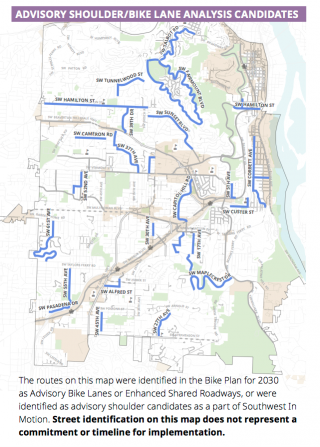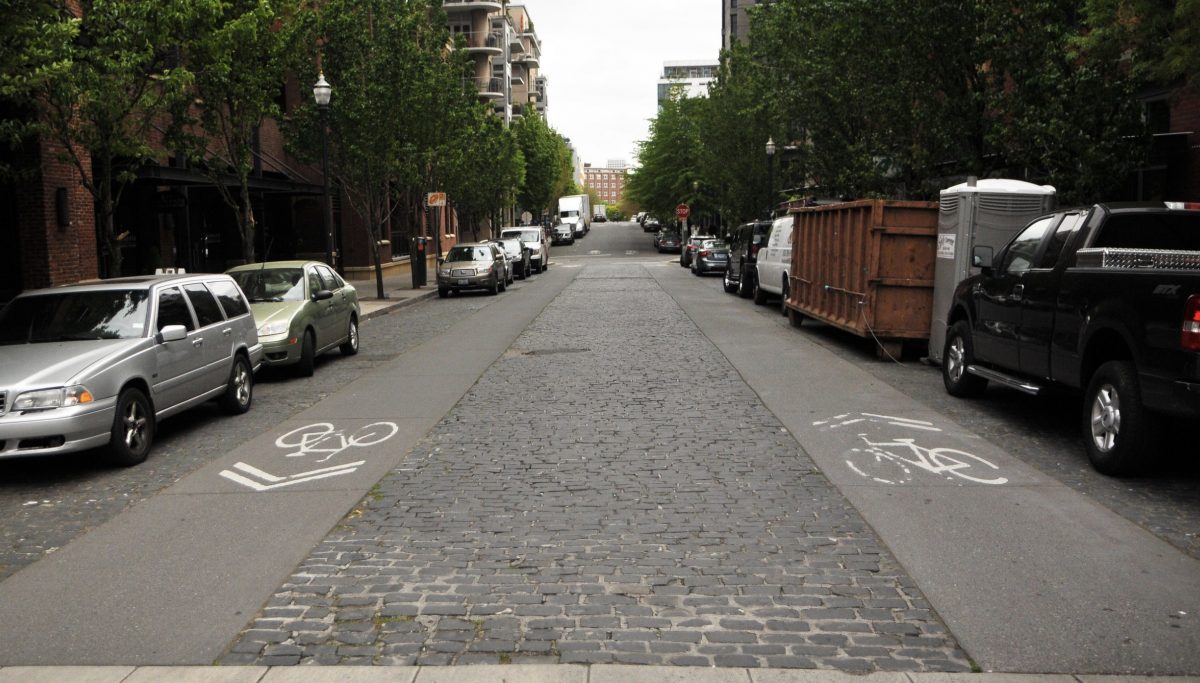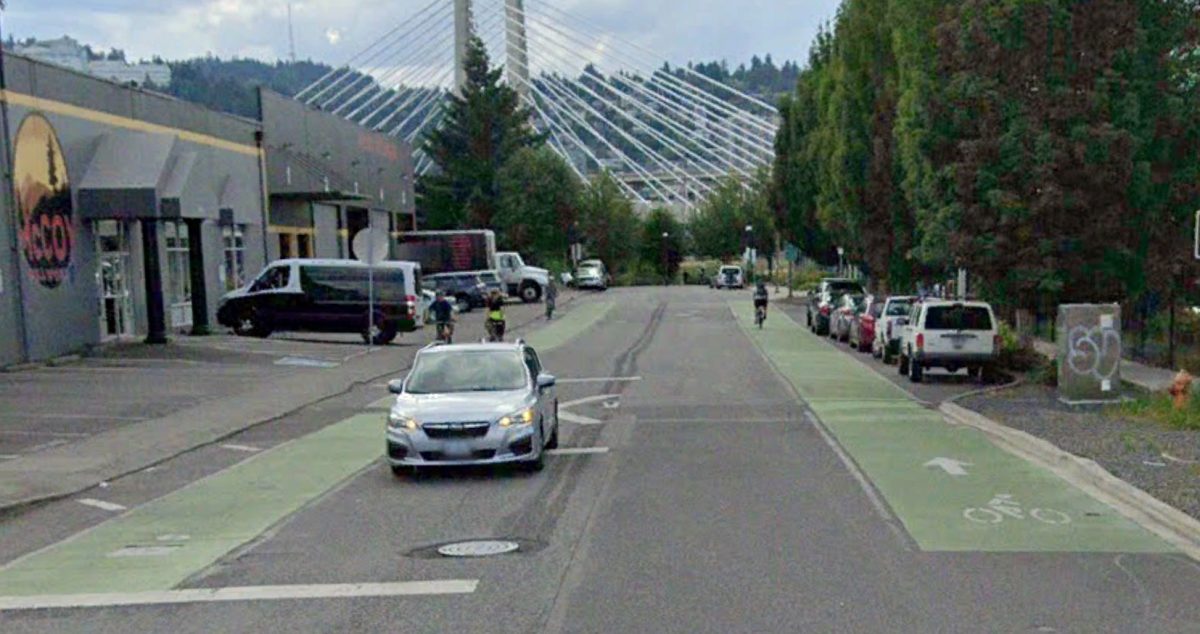
“It seems silly to have the most protected persons with the fewest interactions have all the space designated for them and very little of the road discomfort.”
— Michael Reiss
Southwest Portland resident Michael Reiss is ready to grab some neighbors, a bucket of paint, and have at it. “It” being painting “advisory shoulders” on SW 18th Place, and maybe Maplecrest Drive and 14th too. He’s done his research. He says measuring, designing, and calculating are all in his wheelhouse. And committee meetings? — not so much. He doesn’t like waiting for years.
The advisory shoulder concept his research led him to is an experimental design used on narrow streets with low car volumes that don’t have width for the full suite of facilities — two general purpose lanes, sidewalks and bike lanes — like most streets in southwest Portland. The design reduces the two travel lanes to one bi-directional lane, in which drivers going in opposite directions may pass one another by entering into the advisory shoulder when no people are present. The genius of the design is that it simply formalizes the interactions that regularly occur on narrow roads when a driver pulls to the side to let another driver pass, taking care not to hit anyone.
Advertisement
An engineer by training, Reiss gathered his data, including histograms of travel speed and car counts by hour. His most convincing results are his “number of interactions per trip” for an area walk:
“For pedestrians, an average 30-minute walk results in over half a dozen passes by car users (in either direction). For drivers, even at the times of highest traffic, they average two opposite direction passes with other vehicles. It seems silly to have the most protected persons with the fewest interactions have all the space designated for them and very little of the road discomfort. With advisory shoulders, those two passes would require the drivers to simply (safely) veer into the shoulders.”

Reiss’s aversion to committee meetings might be why he was unaware that the Portland Bureau of Transportation (PBOT) and the Southwest In Motion (SWIM) process, after five years of meetings, had reached the same conclusions he had. In fact, the Bike Plan for 2030 and SWIM had already identified a collection of streets in southwest which would be good candidates for the treatment, including SW 18th Pl and Maplecrest Dr. SWIM even designated two streets on its project list as “pilot” projects for experiment and analysis—SW Talbot and SW Cameron/45th. In the 2019 SWIM project manual, PBOT’s enthusiasm rivaled Reiss’s:
Next Steps for Implementation
PBOT plans to participate in an experimentation and analysis process to conduct pilot project implementation to learn more about where this facility type works best. Southwest Portland has much to gain from successful implementation of advisory shoulders and the inclusion of this design into the PBOT road safety toolbox.Upon successful pilot installation, PBOT should conduct a citywide analysis of potential streets and contexts appropriate for Advisory shoulder implementation. This study should identify appropriate criteria or mitigation for southwest specific concerns related to sight distance, lighting, and operating speed.
Experimentation is required because the advisory lane design is not yet approved in the Federal Highway Administration (FHWA) Manual on Uniform Traffic Control Devices (MUTCD).
Jessica Horning is ODOT’s Bicycle and Pedestrian Coordinator and is listed as a contact by the FHWA. I called Horning to learn about the experimentation process. She explained that the MUTCD is overhauled every 10-12 years and that a new edition is currently in the works. In the decade between updates, a DOT can “request to experiment” on a new road treatment. The process includes 1) Identifying a university partner to conduct a before and after study and 2) determining if you got the expected behavior. “If you get the results you expect, you can then do a larger study,” said Horning. After interim approval, a DOT can send the FHWA a list of streets on which it wants to expand the design. PBOT has completed experiments with the FHWA in the past with green bikeways and bus lanes.


A search of the MUTCD Official Rulings yielded seven cities with active advisory lane experiments. Portland was not on the list. Nor could I find any sign that PBOT had taken action on its pilot streets in southwest — Talbot and Cameron. It appears PBOT has not moved forward on its advisory lane experimentation, although they appear to have made attempts in (at least) two locations: NW Marshall (between 12th and 14th) and SE Caruthers (between SE Grand and the Esplanade path). PBOT did not respond to BikePortland queries in time for publication.
If they work as intended, advisory shoulders would be a boon to southwest Portland where most residential streets don’t have sidewalks, and neither do 65% of the collectors and arterials, (stats which make southwest Portland the area of the city with the worst sidewalk coverage, by far). Add to that the lack of bike infrastructure, sparse bus service everywhere but Barbur Blvd and Beaverton-Hillsdale Hwy, and the Portland policies promoting increased housing density in the region, and you have a recipe for Carmageddon, with residents having few alternatives to car travel.
Meanwhile, it’s spring in Portland, DIY-infrastructure-improvement-projects are in the air. And Michael Reiss is a man on a mission. Stay tuned.
###

— Lisa Caballero, lisacaballero853@gmail.com
— Get our headlines delivered to your inbox.
— Support this independent community media outlet with a one-time contribution or monthly subscription.

